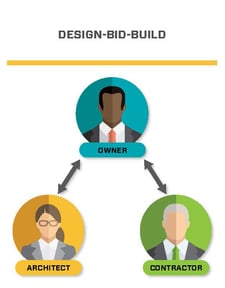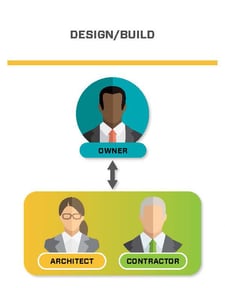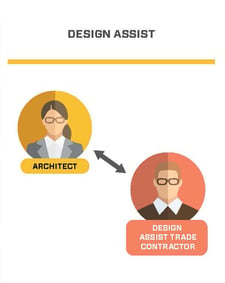Choosing the right delivery approach for your construction project is critical to its success. Between new approaches, the many issues that are involved in your choice, and the interests of stakeholders you might ask to help you make your decision, identifying which delivery method is best suited for your unique needs is complex.
Array Architects has developed this unbiased decision guide as a first step in understanding the differences among today’s choices. It gives a basic explanation of the approach and the contractual ties among the participants, provides some resources for further information, and outlines some of the key advantages and considerations influencing the decision.
 Design-Bid-Build
Design-Bid-Build
This is the traditional and most used approach in the design and construction industry. The owner hires the design team to develop the design, the construction is bid to multiple contractors and then the selected contractor builds the project.
Advantages:
The Owner contracts and works openly with the architect, giving the owner direct influence over design, scope and quality. In this arrangement, the architect serves as the owner’s advocate throughout the course of the project. Design changes are less costly until bids are received because the builder is not yet involved. This well-known approach allows the widest-open field of contractors for bidding competition.
Considerations:
The contractor is usually selected primarily on price rather than qualifications, although qualifications may influence the decision. This process is susceptible to a higher number of change order requests because the low bidder may be trying to compensate for their low bid. The owner manages separate contracts with the architect, and the contractor and mediates disagreements between them – which requires the Owner to have a higher level of experience and knowledge. There is no contractor input during design, requiring a professional cost estimator to be on board to accurately predict construction costs. The bidding process adds time to the project schedule, and actual construction costs are not known until bidding. This approach has limited ability to start construction early without extra effort by the design team. Separate early construction bid packages may add an additional layer of contractors for the owner to manage.
 Design/Build
Design/Build
The owner hires a Design/Build team as the single point of contact for the design and construction process. Usually the builder holds the prime contract with the owner and sub-contracts the architect.
Advantages:
The owner manages one contract and has sole source responsibility for any issues. This process allows for qualification-based selection of the Design/Build team. Emphasis is usually on cost control, and the architect and builder collaborate from the start. The construction cost is established earlier than in Design/Bid/Build and usually after preliminary design. The tighter relationship between the architect and builder can allow an earlier construction start and completion. Change orders are typically reduced.
Considerations:
The architect works for the builder, limiting the architect’s communication with and advocacy for the owner. Since the builder’s commitment to cost is made early, reduced quality may be used to maintain costs. Once the cost commitment is made, the owner has less control of design and construction quality. The builder owns any cost savings achieved after the cost commitment.
 Construction Manager at Risk
Construction Manager at Risk
In this arrangement, the owner separately hires an architect and Construction Manager (CM) early in the design phase to collaborate throughout the project duration. The CM commits to a Guaranteed Maximum Price (GMP), which is usually based on the partially completed construction documents plus reasonably inferred items or tasks. The CM hires the trade contractors and sometimes self-performs a portion of the work.
Advantages:
As a common approach, this offers many experienced providers. It allows the owner to make a qualification-based selection of the architect and the CM. The architect serves as owner’s advocate throughout the project. The architect and CM collaborate from the start, leading to better cost estimating and budget control and possibly earlier start of construction. Construction cost is committed to before the completion of construction documents. Open-book accounting is typical, and the CM is usually paid a percentage of the trade contractor cost plus their on-site expenses which may lead to savings for the owner. The CM holds the risk if construction cost exceeds the GMP.
Considerations:
The owner manages two separate contracts and mediates disagreements which requires owner to have a higher level of experience and knowledge. The owner has less control after the GMP is established and during construction. Design changes after the GMP is established can be costly.
 Integrated Project Delivery
Integrated Project Delivery
Owner, architect and CM enter into a multi-party agreement in which all parties collaborate to achieve established project goals. The knowledge and talents of all parties are integrated to optimize project results.
Advantages:
Owner, architect and CM work in partnership to achieve owner’s project goals. The approach allows for qualification-based selection of architect, CM and key trade contractors. Increased collaboration and a Lean focus on reducing waste can lead to better value and shortened schedule. Open-book accounting by all parties increases transparency. Success is enhanced by goal-achievement incentives and shared savings. Change orders are reduced and litigation is eliminated.
Considerations:
Use may be limited for public owners. This approach requires increased involvement by the owner as a full partner on the project team. The number of qualified and experienced team members may be limited with this fairly new approach. Team members need to build trust and commit to goals to achieve the highest success.
 Design Assist
Design Assist
Qualified trade contractors join the design team during design to provide input and experience on constructability, installation, cost, quality, and other factors impacting design.
Advantages:
The arrangement can be used in any of the delivery approaches. Knowledge and experience of qualified contractors becomes part of the design and can have significant impact on cost, quality, and schedule – especially on large or complex projects. Accuracy of trade estimates during design is enhanced. Constructability reviews by trade contractors can reduce change orders.
Considerations:
The number of qualified and experienced companies may be limited in some areas. Design Assist partners should include those trades that will have a significant impact on project success. Design Assist partners may stay on during construction or may compete in a bidding situation.
Making Your Decision
I hope that his guide is a useful first step in making your decision about a project delivery approach. Each approach has pros and cons, and your project, organizational culture and project team will all impact which is best suited for you. If you have questions about these delivery methods, leave a comment below!
Learn more about Array’s approach to projects in our Planning Design Book.
Blog authored by Ray Corby, prior Engagement Manager with Array.


